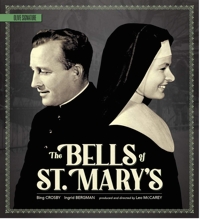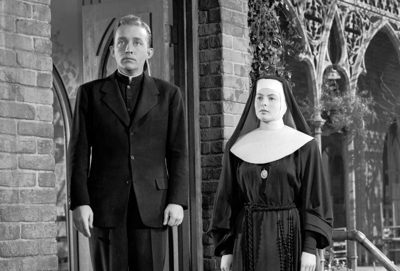 Grade: B
Grade: B
Entire family: Yes
Drama
1945, 126 min., Black & White
Not rated (would be G)
Olive Films
Aspect ratio: 1.37:1
Featured audio: Digital Mono
Bonus features: B
Trailer (spoilers)
Amazon link
Bing Crosby played a priest in two gentle warm-hearted films, Going My Way (1944) and The Bells of St. Mary’s (1945)—the latter of special interest because it paired the crooner with the legendary Ingrid Bergman. She’s the no-nonsense Sister Superior of an urban Catholic school run by nuns and he’s the school’s new easy-going pastor-administrator with a totally different attitude about how to handle problems with children. They really play off each other nicely, and as old-fashioned as this film is, it should interest families who enjoy old black-and-white classics like Miracle on 34th Street. It’s as wholesome a slice of American life as a Norman Rockwell painting that, with age, seems just as quaint.
Like other films from the late ‘40s and early ‘50s, The Bells of St. Mary’s depicts an America that’s long gone, where everything seemed slower paced and children’s problems were limited to trouble with their parents, studies, or classmates. In this film two children’s problems are on the periphery, while the featured character “bout” is a gentle and very subtle rivalry between Father O’Malley and Sister Mary Benedict. The main plot thread involves Sister Benedict’s stubborn hope that a cranky business developer (Henry Travers, who played Clarence in It’s a Wonderful Life) will donate his new building so that it can serve as a new school. He, meanwhile, is angling for St. Mary’s to sell out so he can tear it down and turn it into a parking lot.
Though Father O’Malley arrives in the fall and the story spans the winter months, there is a long scene where students rehearse a Christmas play, and a few other scenes shot in front of decorated trees. So if Diehard is a Christmas movie, so is The Bells of St. Mary’s.
 It’s also a film with teachable moments, with one of them a scene that lends itself to a discussion of those grey areas of morality. Like, what’s the proper response to a bully, and is it right for an adult to “coach” a child to fight? There’s also an embedded history lesson here that someone in your family will instantly want to Google. In one scene, all of the children assemble in the schoolyard to recite the Pledge of Allegiance, but noticeably missing from their recitation is the phrase “under God.” So when was that phrase added? If your children look it up they’ll find that Congress added the phrase on Flag Day 1954 under President Eisenhower.
It’s also a film with teachable moments, with one of them a scene that lends itself to a discussion of those grey areas of morality. Like, what’s the proper response to a bully, and is it right for an adult to “coach” a child to fight? There’s also an embedded history lesson here that someone in your family will instantly want to Google. In one scene, all of the children assemble in the schoolyard to recite the Pledge of Allegiance, but noticeably missing from their recitation is the phrase “under God.” So when was that phrase added? If your children look it up they’ll find that Congress added the phrase on Flag Day 1954 under President Eisenhower.
Originally, audiences preferred Father O’Malley squaring off against a stubborn Father Fitzgibbon (Barry Fitzgerald) in Going My Way, a story about a young priest in a tough neighborhood who helps his financially failing church revive itself. But time has favored the sequel, The Bells of St Mary’s, which now has a 7.3 rating at IMDB.com compared to 7.1 for Going My Way. Leo McCarey directed both films and Crosby, of course, sings in both of them—in this film it’s the title song, “In the Land of Beginning Again,” and “Aren’t You Glad You’re You.” But in truth, the biggest scene stealer isn’t Crosby or Bergman—it’s beloved character actress Una O’Connor, who dusts off her Irish brogue to play the woman who shows Father O’Malley to his room when he arrives and warns him about what he’s getting into with this new situation, surrounded by a bunch of nuns. Seeing her tongue-in-cheek wit at work, viewers might recall O’Connor as Olivia de Haviland’s attendant in The Adventures of Robin Hood or as Barbara Stanwyck’s housekeeper in Christmas in Connecticut.
As I said, it’s all pretty wholesome, and a real time capsule of American life as we like to think it was lived. This sharp-looking Blu-ray “Olive Signature” edition from Olive Films comes with a slipcase and the disc was mastered from a new 4K restoration of the film. Compared to the trailer, the difference is like night and day. Bonus features include a full audio commentary by Crosby biographer Gary Giddins, as well as a bonus feature on “Faith and Film” from Sr. Rose Pecotte, weigh-ins from three film scholars, and Screen Guild Theater radio adaptations that reinforce what the public found appealing in The Bells of St. Mary’s. The film earned Academy Award nominations for Best Picture, Best Actor, Best Actress, Best Director, Best Editing, Best Original Song, Best Music, and Best Sound—but only won for the last category. Still, it’s worth noting that Crosby became the first actor to be nominated twice for portraying the same character.
The Bells of St. Mary’s isn’t rated, but it would merit a G rating for generally mild material. The only questionable scene is the playground fight, but even that’s handled tastefully so that it becomes a homily that one might have just as well encountered sitting in the pews some Sunday.


Leave a comment